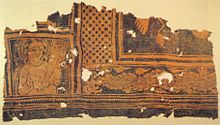Niya (ruined city)
The archaeological site of the ruined city of Niya ( Chinese 尼雅 遺址 / 尼雅 遗址 , Pinyin Níyǎ yízhǐ , English Niya site ) is located on the southern edge of the Tarim Basin in Niya County ( 民丰县 , Minfeng xian ) in the Hotan administrative district , in today's Uighur language Xinjiang Autonomous Region in China . Both places are written in Chinese with different characters.
Numerous ancient archeological artifacts from the various sites during the two Han Dynasties , the Wei Dynasty and the Jin Dynasty have been discovered here. Niya was once a major trading center at an oasis on the southern branch of the Silk Road in the southern Taklamakan Desert. In the old days, the caravans that transported goods from China to Central Asia passed through here .
The Hungarian-British archeologist Aurel Stein has successfully dug here. He discovered there, among other things, Buddhist Kharoṣṭhī documents ( Kharosthi manuscripts ). Some of the Tarim mummies were also found here.
The site has been on the list of monuments of the People's Republic of China in Xinjiang (4-41) since 1996 .
literature
-
Peter Hopkirk : Foreign Devils on the Silk Road: The Search for the Lost Cities and Treasures of Chinese Central Asia . The University of Massachusetts Press, Amherst 1980, ISBN 0-87023-435-8 .
- Peter Hopkirk: The Silk Road. In search of lost treasure in Chinese Central Asia . rororo, Reinbek near Hamburg 1990, ISBN 3-499-18564-4 .
- Zhongguo da baike quanshu : Kaoguxue (Great Chinese Encyclopedia: Volume Archeology). Beijing: Zhongguo da baike quanshu chubanshe, 1986
Web links
- Wang Binghua: The Most Important Findings of Niya in Taklamakan
- Niya yields buried secrets
- Digital Archive of Toyo Bunko Rare Books
- Alpo Ratia: Mannerheim's Central Asian Expedition of 1906-1908 (Engl.)
Footnotes
- ↑ Called Nirang ( 尼 壤 , Nírǎng ) in ancient Chinese texts .
Coordinates: 38 ° 0 ' N , 82 ° 41' E

